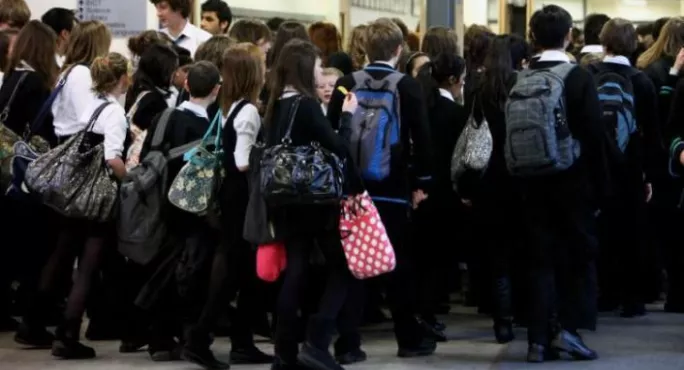
- Home
- Does school uniform still perform any useful function?
Does school uniform still perform any useful function?

Remember those old “Back to School” displays once common in BHS and M&S windows? While they featured small mannequins in painfully smart uniforms, WH Smith pushed pens, rulers and protractors. These promotions would appear, irritatingly, just when teachers, having caught up on sleep, were getting stuck into some serious holidaying.
Everything has its season. The time for children being suspended from school for having dyed hair, excessively tight or short skirts or trainers instead of proper shoes should be early September, the start of the new school year.
This year, by contrast, uniform-based skirmishes have started early.
Affordable school uniforms?
The Welsh government declared that uniforms in its schools must be more affordable, accessible and gender-neutral. Schools are expected to consider whether uniform should vary for summer and winter, and ask themselves whether school logos are “strictly necessary”.
Back in England, Emma Hardy, MP for Hull West and Hessle, accused academies, in particular, of effectively excluding poorer children by “prescribing prohibitively expensive uniforms” beyond the financial reach of their families, including blazers that mimic grammar and private schools.
According to the Children’s Society, families spend £340 a year on secondary-school uniforms, and £255 on primary uniforms. Wales offers parents a pupil-development grant of £125 for uniform, sports kit and equipment, while Scottish councils and English local authorities or academy trusts “may choose” to provide grants.
Bitter conflict
Then we read about the 11-year-old boy currently obliged to choose between cutting off his waist-length hair and taking up the place offered at a prestigious Essex grammar school in September.
Wow. How does the simple idea of wanting kids in school to look broadly similar and smart and to identify with their particular institution become the source of such bitter conflict?
As with many educational conundrums, the problems stem from society’s (and schools’) confusion about the purpose and function of uniform.
School pride
Brits tend to think schools cannot be good without uniform (despite notable exceptions). The early rebranding of schools into academies was frequently signalled by the adoption of bright ties and blazers (strident purple was de rigueur 15 years ago): such garments were pricey, though digital advances nowadays render logos and badges cheap additions.
School uniform is said simultaneously to prevent both individual displays of fashionableness and the comparisons between poor and wealthier children’s clothes that encourage bullying (though this is not a problem in the non-uniform-wearing schools I’ve come across). It’s further claimed that a traditional formal uniform fosters both pride in school and a sense of belonging.
Inconveniently, however, many boys decline to tuck their shirt in or do their tie up, while social and fashion pressures urge girls to wear extremely short skirts, extravagant make-up or jewellery, all in defiance of school rules. In response, some schools ban skirts: trousers for girls are easier to regulate. Girls are denied a “feminine” choice. Meanwhile, in a June heatwave, boys want to wear shorts (or, in protest, skirts).
Groundhog day
Many schools have replaced blazers and ties with branded shirts and pullovers. In Wales, they’re urged to reduce cost further by specifying colour but not style, and by ditching logos.
These well-intentioned proposals will both remove formality and reduce flexibility for girls. When parents shop around, uniform will become neither formal/traditional nor strictly “uniform”. Separate summer and winter uniforms will probably add cost, while “gender-neutral” uniform means trousers.
Hair’s even harder. No rules about colour, length or style are entirely immune from interpretation: parents previously supportive of uniform rules quickly fall out with school when their children are deemed to have transgressed them.
Expensive formal uniform unique to the school excludes poor children. Made cheap and informal, it’s hardly uniform any more. Children demanding flexibility and individuality defy or bend the rules, and find themselves in constant conflict with their school.
So does uniform still perform any useful function, and does it have any measurable effect whatever on education outcomes?
Uniform is schools’ Groundhog Day: a hamster-wheel that, while we remain so confused about it, we cannot get off. So why not start an intelligent conversation about the nature and purpose of uniform in the 21st century? Then, finally, we might get somewhere.
Dr Bernard Trafford is a writer, educationalist, musician and former independent school headteacher. He tweets @bernardtrafford
Register with Tes and you can read five free articles every month, plus you'll have access to our range of award-winning newsletters.
Keep reading for just £4.90 per month
You've reached your limit of free articles this month. Subscribe for £4.90 per month for three months and get:
- Unlimited access to all Tes magazine content
- Exclusive subscriber-only stories
- Award-winning email newsletters
You've reached your limit of free articles this month. Subscribe for £4.90 per month for three months and get:
- Unlimited access to all Tes magazine content
- Exclusive subscriber-only stories
- Award-winning email newsletters



